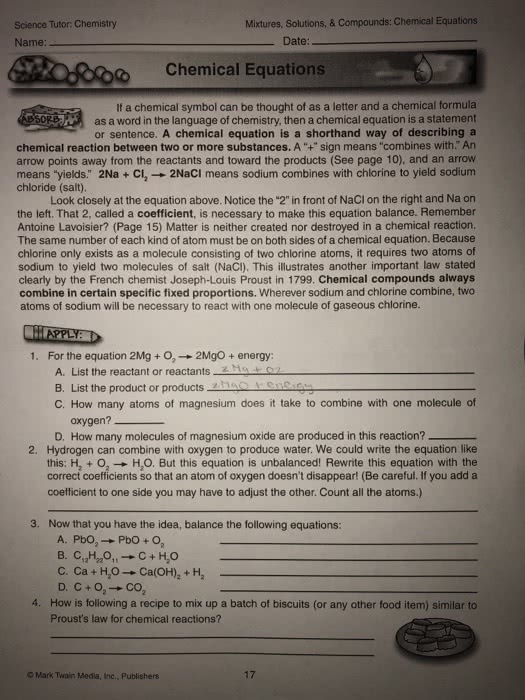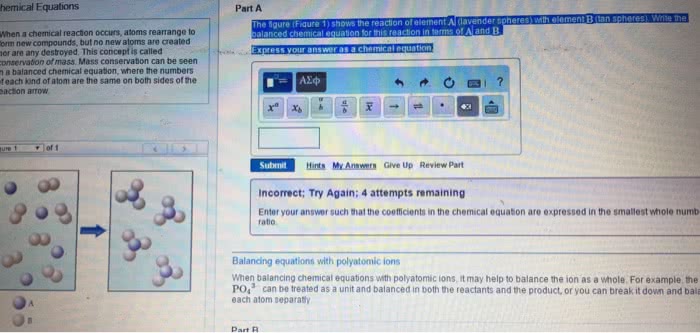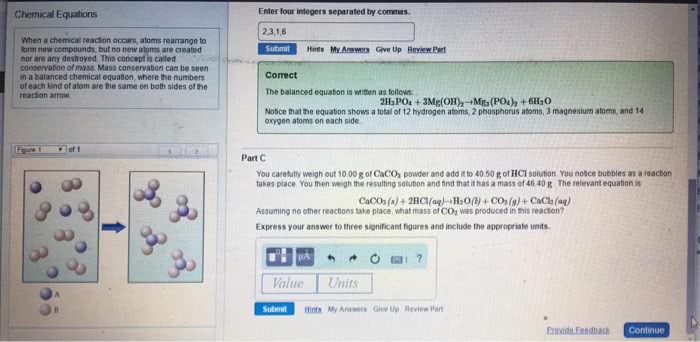CHEM 110 Chapter Notes - Chapter 4: Bmw I8, Limiting Reagent, Reducing Agent

Chapter 4 – Chemical Reactions & Stoichiomestry
Writing & Balancing Chemical Equations
- Combustion employs a chemical reaction
o Process in which one or more substances are converted into one or more different
ones
▪ Example: Water can be made by hydrogen & Oxygen
o Combustion reaction is a chemical reaction in which a substance combines with
oxygen to form one or more oxygen-containing compounds
▪ They also produce heat that is critical in supplying energy needs
- Chemical equation
o Represents a chemical reaction
▪ Example: Combustion of natural gas is seen as
▪ Substance on the left is the reactant
▪ Substance on the right is the product
• Must balance the equation
o Change the coefficients and not the subscripts
▪ Coefficients are found in front of the chemical
▪ Subscripts found within the chemical formula
o Change the number of molecules in the equation but not the
kind of molecules
▪ Example: CH4 + O2 CO2 + 2 H2O
• To balance the equation, must put a 2 before
O2 in the Reactants and 2 before H2O
▪ Balanced: CH4 + 2 O2 CO2 + 2 H2O
• 8 Reactants 8 Products
o The balanced equation tells us that one CH4 reacts with two O2 molecules to form
one CO2 and two H2O molecules.
▪ CH4(g) + 2 O2(g) → CO2(g) + 2 H2O(g)
• Reactants: 1 C atom (1 × CH4), 4 H atoms (1 × CH4), 4 O atoms (2
× O2)
• Products: 1 C atom (1 × CO2), 4 H atoms (2 × H2O), 4 O atoms (2
× O2), 4 O atoms (1 × CO2 + 2 × H2O)
o Procedure
▪ Write a skeleton equation by writing chemical formulas for each of the
reactants and products
▪ Balance atoms that occur in the complex substances first
• Compounds first then elements
▪ Balance atoms as free elements on either side last
▪ Use a table to ensure the balance is summed
Solutions and Solubility
- Homogenous mixture of two substances is a solution
- A majority component is the solvent and minority is the solute
- When sodium chloride is put into water, Na+ and Cl- compete with the attraction
find more resources at oneclass.com
find more resources at oneclass.com

Electrolye and Nonelectrolyte Solutions
- Dissolved ions act as charge carriers, allowing solution to conduct electricity
- Electrolytes are substances that dissolve in water to form solutions that conduct
electricity
o Substances that dissolve in water are strong electrolyes (Sodium chloride)
- Sugar is a molecular compound dissolve in water as molecules which remain in tact
o This is called a non-electrolyte
▪ Does not dissolve in water
- Hydrochloric acid is a molecular compound that ionizes into H+ and Cl- when it dissolves
in water
o This is a strong acid
▪ Completely ionizes in solution
o Weak Acids are formed of nonionized form of acid molecules
▪ Classified as weak electrolytes and conduct electricity weakly
Solubility of ionic Compounds
- Solubility rules
o All salts containing cations of group 1 metals (Alkali metals, Li+, Na+, K+) and
NH4 are soluble
o All nitrates, ethanoates, chlorates, and perchlorates are soluble
o compounds containing Ag+, Pb2+, and Hg22+ are insoluble
o Chlorides, Bromides, and Iodides are soluble
o Sulfates are soluble except those with Ca2+, Sr2+, Ba2+
o Carbonates, Hydroxides, Oxides Phosphates and Sulfides are insoluble
Percipitation Reactions
- Reactions between Ca2+ or Mg2+ with CO32- are examples of precipitation reactions
o Solid or precipitate forms when we mix two solutions
o Two solutions containing soluble compounds combine and an insoluble
compound precipitates (Soluble + Soluble Insoluble)
▪ Example: When Potassium iodide and lead (II) Nitrate are combined, a
yellow precipitate is formed.
▪ Example: KI and Pb(NO3)2 are soluble
• cation from either compound can pair with the anion from the
other to form possibly insoluble products
o KNO3 is soluble, but PbI2 is insoluble. Consequently, PbI2
precipitates.
▪ Example: AgNO3 + NaBr
• Cations are Ag & Na
• Anions are NO3 & Br
• AgNO3 + NaBr AgBr + NaNO3
▪ In a complete ionic equation, Spectator ions are on both the reactant and
product side
find more resources at oneclass.com
find more resources at oneclass.com

• Net iconic equation is useful because it shows the species that take
part in the reaction
o Procedure
▪ Write formula of the 2 compounds being mixed as
reactants
▪ Write the ions that are present when the ionic
compounds dissolve in water and determine the
possible products formed
▪ Use solubility rules
▪ If all products are soluble, there is no reaction or net
iconic equation
• If INSOLUBLE write the net iconic
equation
Acid-Base Reactions
- In Acid-Base reactions, an acid reacts with a base and the two neutralize each other,
producing water
- Arrhenius Definitions of acid and bases are the following:
o Acid: Substances that produce H+ ions
o Base: Substances that produce OH- ions
o Polyprotic Acids: Contain more than one ionizable protein and can release them
▪ Sulfuring Acid H2SO4 is diprotic
o When we mix an acid and a base, the H+ combines with OH- to form H2O
Acid Base evolving a Gas
- Two aqueous solution mix to form a gaseous product that bubbles out of solution called
Gas-Evolution reactions
o When Sulufiric acid reacts with lithium sulfide, dihydrogen sulfide is formed
▪ H2SO4(aq) + Li2S(aq) → H2S(g) + Li2SO4(aq)
o Similarly, when acids composed of ammonium cation react in an acid–base
reaction in aqueous solution, ammonia gas is evolved:
▪ NH4Cl(aq) + NaOH(aq) → H2O(l) + NH3(g) + NaCl(aq)
Oxidation reduction Reactions
- Electron transfer from one reactant to the other
o Involve the reaction of a substance with oxygen
▪ Example: When sodium reacts with chlorine, electrons transfer from
Sodium to the chlorine resulting in sodium chloride
o Hydrogen loses electron density (Oxidation) and chlorine gains electron density
(reduction)
o Oxidation state of an atom is the charge it would have if all the shared electrons
were assigned to the atom with greatest attraction
▪ HCl
find more resources at oneclass.com
find more resources at oneclass.com
Document Summary
O2: products: 1 c atom (1 co2), 4 h atoms (2 h2o), 4 o atoms (2. Homogenous mixture of two substances is a solution. A majority component is the solvent and minority is the solute. When sodium chloride is put into water, na+ and cl- compete with the attraction. Dissolved ions act as charge carriers, allowing solution to conduct electricity. Electrolytes are substances that dissolve in water to form solutions that conduct electricity: substances that dissolve in water are strong electrolyes (sodium chloride) Sugar is a molecular compound dissolve in water as molecules which remain in tact: this is called a non-electrolyte, does not dissolve in water. Solubility rules: all salts containing cations of group 1 metals (alkali metals, li+, na+, k+) and. Reactions between ca2+ or mg2+ with co3. Consequently, pbi2 precipitates: example: agno3 + nabr, cations are ag & na, anions are no3 & br, agno3 + nabr agbr + nano3.




